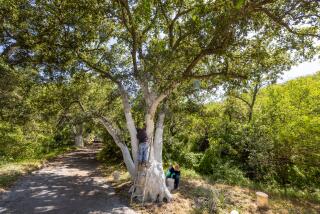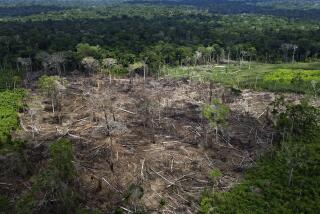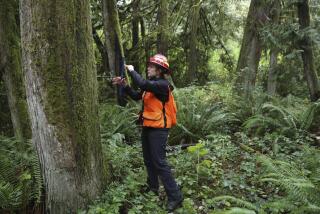Ash dieback disease could alter the landscape of England
ASSINGTON, England — Like a long-kept secret, the grove of ash trees sprang up unbidden out of soil left fallow after years of cultivation. An army of saplings now covers more than 30 acres of former farmland near this peaceful village, delighting the conservationists who bought the property less than a decade ago for use as a wildlife reserve.
But what nature giveth, nature taketh away.
Some of the 10-foot-tall seedlings here in the plot of land known as Hullback’s Grove bear discolored bands of bark, a distressed-looking brown compared with the normal, healthy green. It’s a telltale sign of Chalara fraxinea, a killer fungus that causes ash dieback disease, which has already decimated the ash population in parts of continental Europe.
To the consternation of the British public, the scourge has crossed the English Channel and now threatens to radically alter the landscape of this island nation’s picture-book countryside.
About 11% of England’s forest cover is made up of ash, which is considered one of the nation’s iconic trees, along with species such as oak and plane. One estimate puts Britain’s number of ash trees at about 80 million, more than the number of people.
Its distinctive mesh-patterned bark and finger-like leaves are home to beetles, finches, owls and other wildlife.
Britons have prized ash trees through the centuries for excellent firewood; used it to make sports equipment such as field hockey sticks; and eulogized the tree in the melancholy Welsh folk song “The Ash Grove,” a tune familiar to many Americans.
But the specimens in Hullback’s Grove are in trouble.
“They’re just being starved,” site manager William Cranstoun says of the infected trees, which lose precious water to the attacking fungus. Saplings less than 8 years old are in danger of dying within months. “The thing that’s worrying is the rate that it happens,” Cranstoun says.
Alarmed by the menace to their natural environment, British forestry officials have gone into emergency mode to combat an exotic disease for which there is no cure.
Tens of thousands of British ash trees have been chopped down and burned to try to prevent the fungus’ spread. But the malevolent red spots on official maps that chart its presence continue to grow. Experts say bleakly that eradication is probably impossible, at least in the near term.
“It’s here to stay,” says Cranstoun, who works for the Suffolk Wildlife Trust.
That has nature lovers looking nervously at Denmark as a warning of things to come. Ninety percent of the Scandinavian country’s ash trees have been sickened by the fungus; many have died, a catastrophe in a land where ancient Norse mythology says that a giant ash supports the universe. Poland, too, has been hit hard.
Young ash plantings are more susceptible, but mature trees can also fall victim, a cause of particular grief here in a land where ancient woodlands are celebrated in art (think of paintings by John Constable), literature (Robin Hood and Sherwood Forest) and even politics (an addendum to the Magna Carta contains clauses on forestry rights). Some mighty ash specimens date back more than half a millennium.
In some forests, the leafy green ash trees are just one of a diverse mix of species. But Britain boasts enough ash-dominated woods to cover 500 square miles, especially in the scenic Peak District of northern England, where their widespread destruction by disease would be devastating.
“That woodland structure would be changed more or less irrevocably,” says Austin Brady, the head of conservation at the Woodland Trust, a nonprofit organization. “And conservation wildlife in that part of the world would suffer.”
Ash dieback was first detected this year in seedlings imported from the Netherlands. But concern exploded in October when botanists discovered the disease in the wild, outside of the nursery trade, mostly in counties along the eastern and southern coasts of England.
That has led scientists to conclude that the disease’s presence here is not merely the result of human commercial activity; spores of the fungus were probably blown over or brought by birds from the European mainland, which lies just 21 miles from the chalky white cliffs of Dover.
The government of Prime Minister David Cameron, which is implementing the deepest public spending cuts in a generation, has been accused of mounting a slow and fumbling response to the deadly incursion of Chalara fraxinea.
Last month, the Cabinet’s crisis-response team convened to address ash dieback and mobilized hundreds of government employees to scope out the extent of the problem.
As of Tuesday, officials had found 309 infected sites, more than half of them in the wild. The government is exhorting Britain’s hordes of hikers, park-goers and other forest visitors to clean their footwear and the tires on their vehicles to help contain the disease.
“We have to retain a sense of optimism here that it is potentially controllable,” Ian Boyd, chief scientific advisor to the Department for Environment, Food and Rural Affairs, said in October.
But he added, “At the end of the day, biology may rule, and there may be relatively little we can do about it.”
Conservationists fear a repeat of the terrible blight inflicted on the British landscape in the 1970s by Dutch elm disease, which destroyed tableaux of great pastoral beauty immortalized in countless depictions of the English countryside.
Contrary to some outside perceptions of this “green and pleasant land,” Britain’s forest cover is actually low by European standards: about 13%, compared with as much as 40% in other parts of Europe. But that only encourages Britons to cherish their trees all the more and, in many ways, to view them as important witnesses to and repositories of their nation’s long and colorful history.
“We have quite an intimate, small-scale landscape,” conservationist Brady says. “We don’t have the vast open spaces or large areas of forests you have in the U.S. So the way people engage with the countryside and with the landscape is quite different for us.”
Here in Hullback’s Grove, part of a larger wildlife reserve known as Arger Fen & Spouse’s Vale, “ramblers” and other visitors from miles around squelch over muddy tracks to admire cherry blossoms and to spot dormice.
The stands of ash saplings rose up after the Suffolk Wildlife Trust bought Hullback’s Grove, previously arable fields, in 2004 and left the area to its own devices. With the advent of ash dieback disease, site manager Cranstoun says, the trust has decided to do the same again: Let nature take its course.
That could mean letting the fungus lay waste to a swath of burgeoning forest. But scientists say that a small number of naturally resistant trees should survive, which could form the basis of breeding stock for hardier descendants.
In time, they hope, the lessons from this new plague will prove valuable.
“The problem with ash is horrendous,” Brady says. “But of course, there are other known pests and diseases out there that could be affecting other species. We should use that as a wake-up call to say, look, there are other issues on our doorstep.”
More to Read
Sign up for Essential California
The most important California stories and recommendations in your inbox every morning.
You may occasionally receive promotional content from the Los Angeles Times.











